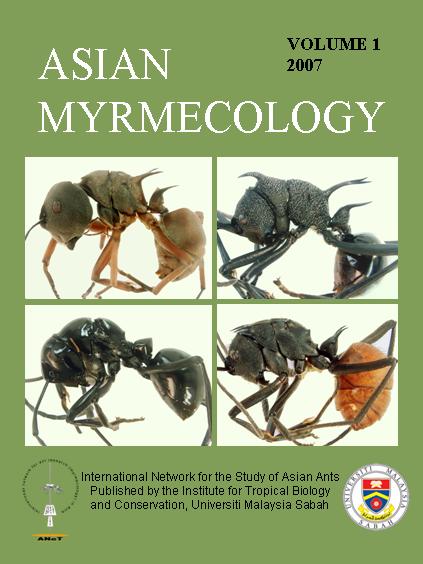ASIAN
MYRMECOLOGY
Image: François Brassard
Ecology and Distribution
Asian Myrmecology, Volume 1, pages 69-79, published August 2007
DOI: 10.20362/am.001007
Ants of the Klong U-Tapao Basin, Southern Thailand
SUPAROEK WATANASIT*, JAREARNSAK SAEWAI & AMPHON PHLAPPLUENG
Abstract:
Ton Nga Chang Wildlife Sanctuary is located in the Khao Ban Thad Mountain Range, in the southern part of Thailand. It serves as a watershed for the Klong U-Tapao Basin that collects water from many streams, draining via Hat Yai City into Songkhla Lake. It might be expected that the diversity of habitat types along the streams from the watershed to the lake should be reflected in the diversity of fauna and flora. Ants play important roles in the ecosystem, and the aim of this study was to examine the distribution of ants in different habitats along the stream of the Klong U-Tapao Basin. Five study sites were chosen within the following categories: three from the forest watershed area of the Wildlife Sanctuary and two from agricultural landscapes downstream. At each study site, three permanent plots of 20 x 20 m were selected for sampling. Two sampling methods, hand collecting (HC) and leaf litter sampling (LL), were used to collect ants within a time limit of 30 minutes for each method in each permanent plot; sampling took place every two months from January 2003 to January 2004. We collected 248 species of ants in 50 genera and seven subfamilies: Aenictinae, Cerapachyinae, Dolichoderinae, Formicinae, Myrmicinae, Ponerinae and Pseudomyrmecinae. The majority of species were in the Myrmicinae (43%) and Formicinae (31%). Detrended Correspondence Analysis (DCA) distinguished between the two groups of sites (forested watershed area and downstream agricultural landscape) and the different sampling methods (HC and LL). In conclusion, this study indicates that the distribution of ant species does vary along the Klong U-Tapao Basin, and that natural forest areas differ substantially from agricultural habitats.
Keywords:
diversity, ants, sampling methods, site, Klong U-Tapao Basin, Songkhla Lake, Southern Thailand
Get PDF (1100K):
Department of Biology, Faculty of Science, Prince of Songkla University, Hat Yai, Songkhla Thailand 90112
*Corresponding author: suparoek.w@psu.ac.th



